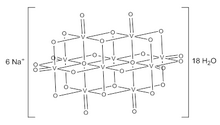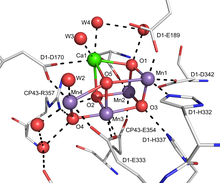
A transition metal oxo complex is a coordination complex containing an oxo ligand. Formally O, an oxo ligand can be bound to one or more metal centers, i.e. it can exist as a terminal or (most commonly) as bridging ligands. Oxo ligands stabilize high oxidation states of a metal. They are also found in several metalloproteins, for example in molybdenum cofactors and in many iron-containing enzymes. One of the earliest synthetic compounds to incorporate an oxo ligand is potassium ferrate (K2FeO4), which was likely prepared by Georg E. Stahl in 1702.
Reactivity
Olation and acid-base reactions

A common reaction exhibited by metal-oxo compounds is olation, the condensation process that converts low molecular weight oxides to polymers with M-O-M linkages. Olation often begins with the deprotonation of a metal-hydroxo complex. It is the basis for mineralization and the precipitation of metal oxides. For the oxides of d0 metals, V, Nb, Ta, Mo, and W, the olation process affords polyoxometallates, a large class of molecular metal oxides.
Oxygen-atom transfer
Metal oxo complexes are intermediates in many metal-catalyzed oxidation reactions. Oxygen-atom transfer is common reaction of particular interest in organic chemistry and biochemistry. Some metal-oxos are capable of transferring their oxo ligand to organic substrates. One such example of this type of reactivity is from the enzyme superfamily molybdenum oxotransferase.
In water oxidation catalysis, metal oxo complexes are intermediates in the conversion of water to O2.
Hydrogen-atom abstraction
Transition metal-oxo's are also capable of abstracting strong C–H, N–H, and O–H bonds. Cytochrome P450 contains a high-valent iron-oxo which is capable of abstracting hydrogen atoms from strong C–H bonds.
Molecular oxides
Some of the longest known and most widely used oxo compounds are oxidizing agents such as potassium permanganate (KMnO4) and osmium tetroxide (OsO4). Compounds such as these are widely used for converting alkenes to vicinal diols and alcohols to ketones or carboxylic acids. More selective or gentler oxidizing reagents include pyridinium chlorochromate (PCC) and pyridinium dichromate (PDC). Metal oxo species are capable of catalytic, including asymmetric oxidations of various types. Some metal-oxo complexes promote C-H bond activation, converting hydrocarbons to alcohols.

Selection of molecular metal oxides. From left, vanadyl chloride (d), a tungsten oxo carbonyl (d), permanganate (d), (d), simplified view of compound I (a state of cytochrome P450, d), and Ir(O)(mesityl)3 (d).
Metalloenzymes
Iron(IV)-oxo species

Iron(IV)-oxo compounds are intermediates in many biological oxidations:
- Alpha-ketoglutarate-dependent hydroxylases activate O2 by oxidative decarboxylation of ketoglutarate, generating Fe(IV)=O centers, i.e. ferryl, that hydroxylate a variety of hydrocarbon substrates.
- Cytochrome P450 enzymes, use a heme cofactor, insert ferryl oxygen into saturated C–H bonds, epoxidize olefins, and oxidize aromatic groups.
- Methane monooxygenase (MMO) oxidizes methane to methanol via oxygen atom transfer from an iron-oxo intermediate at its non-heme diiron center. Much effort is aimed at reproducing reactions with synthetic catalysts.
Molybdenum/tungsten oxo species

The oxo ligand (or analogous sulfido ligand) is nearly ubiquitous in molybdenum and tungsten chemistry, appearing in the ores containing these elements, throughout their synthetic chemistry, and also in their biological role (aside from nitrogenase). The biologically transported species and starting point for biosynthesis is generally accepted to be oxometallates MoO4 or WO4. All Mo/W enzymes, again except nitrogenase, are bound to one or more molybdopterin prosthetic group. The Mo/W centers generally cycle between hexavalent (M(VI)) and tetravalent (M(IV)) states. Although there is some variation among these enzymes, members from all three families involve oxygen atom transfer between the Mo/W center and the substrate. Representative reactions from each of the three structural classes are:
- Sulfite oxidase: SO3 + H2O → SO4 + 2 H + 2 e
- DMSO reductase: H3C–S(O)–CH3 (DMSO) + 2 H + 2 e → H3C–S–CH3 (DMS) + H2O
- Aldehyde ferredoxin oxidoreductase: R–CHO + H2O → R–CO2H + 2 H + 2 e
The three different classes of molybdenum cofactors are shown in the adjacent figure. The biological use of tungsten mirrors that of molybdenum.
Oxygen-evolving complex
The active site for the oxygen-evolving complex (OEC) of photosystem II (PSII) is a Mn4O5Ca centre with several bridging oxo ligands that participate in the oxidation of water to molecular oxygen. The OEC is proposed to utilize a terminal oxo intermediate as a part of the water oxidation reaction. This complex is responsible for the production of nearly all of earth's molecular oxygen. This key link in the oxygen cycle is necessary for much of the biodiversity present on earth.

The "oxo wall"

The term "oxo wall" is a theory used to describe the fact that no terminal oxo complexes are known for metal centers with octahedral symmetry and d-electron counts beyond 5.
Oxo compounds for the vanadium through iron triads (Groups 3-8) are well known, whereas terminal oxo compounds for metals in the cobalt through zinc triads (Groups 9-12) are rare and invariably feature metals with coordination numbers lower than 6. This trend holds for other metal-ligand multiple bonds. Claimed exceptions to this rule have been retracted.
The iridium oxo complex Ir(O)(mesityl)3 may appear to be an exception to the oxo-wall rule, but it is not because the complex is non-octahedral. The trigonal symmetry reorders the metal d-orbitals below the degenerate MO π* pair. In three-fold symmetric complexes, multiple MO bonding is allowed for as many as 7 d-electrons.
Terminal oxo ligands are also rather rare for the titanium triad, especially zirconium and hafnium and are unknown for group 3 metals (scandium, yttrium, and lanthanum).
See also
References
- ^ Nugent, W. A., Mayer, J. M. "Metal-Ligand Multiple Bonds." John Wiley & Sons, New York, 1988.
- Delaude, Lionel; Laszlo, Pierre (1996-01-01). "A Novel Oxidizing Reagent Based on Potassium Ferrate(VI)1". The Journal of Organic Chemistry. 61 (18): 6360–6370. doi:10.1021/jo960633p. hdl:2268/15390. ISSN 0022-3263. PMID 11667478.
- Holm, R. H. (1987). "Metal-centered oxygen atom transfer reactions". Chem. Rev. 87 (6): 1401–1449. doi:10.1021/cr00082a005.
- Meunier, Bernard; de Visser, Samuël P.; Shaik, Sason (2004). "Mechanism of Oxidation Reactions Catalyzed by Cytochrome P450 Enzymes". Chemical Reviews. 104 (9): 3947–3980. doi:10.1021/cr020443g. ISSN 0009-2665. PMID 15352783.
- Du, G.; Abu-Omar, M. M. (2008). "Oxo and Imido Complexes of Rhenium and Molybdenum in Catalytic Reductions". Current Organic Chemistry. 12 (14): 1185–1198. doi:10.2174/138527208785740238.
- ^ Gunay, A.; Theopold, K. H. (2010). "C-H Bond Activations by Metal Oxo Compounds". Chem. Rev. 110 (2): 1060–1081. doi:10.1021/cr900269x. PMID 20143877.
- ^ Hay-Motherwell, Robyn S.; Wilkinson, Geoffrey; Hussain-Bates, Bilquis; Hursthouse, Michael B. (1993). "Synthesis and X-ray Crystal Structure of Oxotrimesityl-Iridium(V)". Polyhedron. 12 (16): 2009–2012. doi:10.1016/S0277-5387(00)81474-6.
- Huang, Xiongyi; Groves, John T. (2017). "Beyond Ferryl‑Mediated Hydroxylation: 40 Years of the rebound mechanism and C–H activation". J Biol Inorg Chem. 22 (2–3): 185–207. doi:10.1007/s00775-016-1414-3. PMC 5350257. PMID 27909920.
- Hausinger, R. P. (January–February 2004). "Fe(II)/α-Ketoglutarate-Dependent Hydroxylases and Related Enzymes". Crit. Rev. Biochem. Mol. Biol. 39 (1): 21–68. doi:10.1080/10409230490440541. PMID 15121720. S2CID 85784668.
- Ortiz de Montellano, Paul R. (2010). "Hydrocarbon Hydroxylation by Cytochrome P450 Enzymes". Chemical Reviews. 110 (2): 932–948. doi:10.1021/cr9002193. ISSN 0009-2665. PMC 2820140. PMID 19769330.
- Coon, M. J. (1998-01-20). "Epoxidation of olefins by cytochrome P450: Evidence from site-specific mutagenesis for hydroperoxo-iron as an electrophilic oxidant". Proceedings of the National Academy of Sciences. 95 (7): 3555–60. Bibcode:1998PNAS...95.3555V. doi:10.1073/pnas.95.7.3555. PMC 19874. PMID 9520404.
- Farinas, Edgardo T; Alcalde, Miguel; Arnold, Frances (2004). "Alkene epoxidation catalyzed by cytochrome P450 BM-3 139-3". Tetrahedron. 60 (3): 525–528. doi:10.1016/j.tet.2003.10.099. ISSN 0040-4020.
- Korzekwa, Kenneth; Trager, William; Gouterman, Martin; Spangler, Dale; Loew, Gilda (1985). "Cytochrome P450 mediated aromatic oxidation: a theoretical study". Journal of the American Chemical Society. 107 (14): 4273–4279. Bibcode:1985JAChS.107.4273K. doi:10.1021/ja00300a033. ISSN 0002-7863.
- Brunold, T.C. (2007). "Synthetic Iron-Oxo 'Diamond Core' Mimics Structure of Key IIntermediate in Methane Monooxygenase Catalytic Cycle". Proc. Natl. Acad. Sci. U.S.A. 104 (52): 20641–20642. Bibcode:2007PNAS..10420641B. doi:10.1073/pnas.0710734105. PMC 2409203. PMID 18093936.
- Schwarz, G.; Mendel, R. R.; Ribbe, M. W. (2009). "Molybdenum Cofactors, Enzymes and Pathways". Nature. 460 (7257): 839–847. Bibcode:2009Natur.460..839S. doi:10.1038/nature08302. PMID 19675644. S2CID 205217953.
- Mukund, S.; Adams, M. W. W. (1996). "Molybdenum and Vanadium Do not Replace Tungsten in the Catalytically Active Forms of the Three Tungstoenzymes in the Hyperthermophilic Archaeon Pyrococcus furiosus". J. Bacteriol. 178 (1): 163–167. doi:10.1128/jb.178.1.163-167.1996. PMC 177634. PMID 8550411.
- ^ Umena, Yasufumi; Kawakami, Keisuke; Shen, Jian-Ren; Kamiya, Nobuo (2011). "Crystal structure of oxygen-evolving photosystem II at a resolution of 1.9 Å" (PDF). Nature. 473 (7345): 55–60. Bibcode:2011Natur.473...55U. doi:10.1038/nature09913. ISSN 0028-0836. PMID 21499260. S2CID 205224374.
- ^ Winkler, Jay R.; Gray, Harry B. (2012). "Electronic Structures of Oxo-Metal Ions". In Mingos, David Michael P.; Day, Peter; Dahl, Jens Peder (eds.). Molecular Electronic Structures of Transition Metal Complexes I. Structure and Bonding. Vol. 142. Springer Nature. pp. 17–28. doi:10.1007/430_2011_55. ISBN 978-3-642-27369-8.
- Larson, Virginia A.; Battistella, Beatrice; Ray, Kallol; Lehnert, Nicolai; Nam, Wonwoo (2020). "Iron and manganese oxo complexes, oxo wall and beyond". Nature Reviews Chemistry. 4 (8): 404–419. doi:10.1038/s41570-020-0197-9. PMID 37127969. S2CID 220295993.
- Anderson, Travis M.; Neiwert, Wade A.; Kirk, Martin L.; Piccoli, Paula M. B.; Schultz, Arthur J.; Koetzle, Thomas F.; Musaev, Djamaladdin G.; Morokuma, Keiji; Cao, Rui; Hill, Craig L. (2004-12-17). "A Late-Transition Metal Oxo Complex: K7Na9[O=PtIV(H2O)L2], L = [PW9O34]9-". Science. 306 (5704): 2074–2077. doi:10.1126/science.1104696. ISSN 0036-8075. PMID 15564312. S2CID 41123922. (Retracted, see doi:10.1126/science.337.6092.290-a, PMID 22822129, Retraction Watch)
- Anderson, Travis M.; Cao, Rui; Slonkina, Elena; Hedman, Britt; Hodgson, Keith O.; Hardcastle, Kenneth I.; Neiwert, Wade A.; Wu, Shaoxiong; Kirk, Martin L.; Knottenbelt, Sushilla; Depperman, Ezra C. (2005-08-01). "A Palladium-Oxo Complex. Stabilization of This Proposed Catalytic Intermediate by an Encapsulating Polytungstate Ligand". Journal of the American Chemical Society. 127 (34): 11948–11949. Bibcode:2005JAChS.12711948A. doi:10.1021/ja054131h. ISSN 0002-7863. PMID 16117527. (Retracted, see doi:10.1021/ja207910h, PMID 22873777, Retraction Watch)
- Cao, Rui; Anderson, Travis M.; Piccoli, Paula M. B.; Schultz, Arthur J.; Koetzle, Thomas F.; Geletii, Yurii V.; Slonkina, Elena; Hedman, Britt; Hodgson, Keith O.; Hardcastle, Kenneth I.; Fang, Xikui (2007-09-01). "Terminal Gold-Oxo Complexes". Journal of the American Chemical Society. 129 (36): 11118–11133. Bibcode:2007JAChS.12911118C. doi:10.1021/ja072456n. ISSN 0002-7863. PMID 17711276. (Retracted, see doi:10.1021/ja207909y, PMID 22873776, Retraction Watch)
- O’Halloran, Kevin P.; Zhao, Chongchao; Ando, Nicole S.; Schultz, Arthur J.; Koetzle, Thomas F.; Piccoli, Paula M. B.; Hedman, Britt; Hodgson, Keith O.; et al. (2012). "Revisiting the Polyoxometalate-Based Late-Transition-Metal-Oxo Complexes: The "Oxo Wall" Stands". Inorganic Chemistry. 51 (13): 7025–7031. doi:10.1021/ic2008914. PMID 22694272.
- Ritter, Stephen K. (June 12, 2012). "Metal-Oxo Papers Retracted". cen.acs.org. Retrieved 2021-05-15.
- Hadlington2012-06-14T00:00:00+01:00, Simon. "Oxo wall still stands as inorganic papers retracted". Chemistry World. Retrieved 2021-05-15.
{{cite web}}: CS1 maint: numeric names: authors list (link)
| Coordination complexes | |
|---|---|
| H donors: | |
| B donors: | |
| C donors: | |
| Si donors: | |
| N donors: | |
| P donors: | |
| O donors: | |
| S donors: | |
| Halide donors: | |